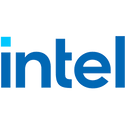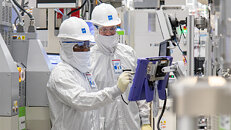Monday, July 28th 2025

Intel Foundry Services "Unsuccessful" at Attracting External Customers: 10-Q Filing
Intel in its latest 10-Q filing with the US SEC revealed that the company has been "unsuccessful to date" in attracting significant customers to its external foundry business. Traditionally dedicated to manufacturing Intel products, the company's foundry had over the years reorganized itself into Intel Foundry Services, and opened its doors to manufacturing chips for external customers the way Samsung Electronics does. While Samsung's foundry manufactures SoCs, DRAM, and NAND flash products for itself, it's also been a contract manufacturer of cutting edge logic chips. For example, NVIDIA's GeForce "Ampere" GPUs were made on a Samsung 8 nm node. Intel was eying a similar future for its foundry, however, major chip designers seem less than enthusiastic.
Intel battled foundry woes since the second half of the 2010s, when its switch from 14 nm to 10 nm took much longer than expected, and a resurgent AMD building chips on TSMC 7 nm adding pressure on Intel Products to court TSMC. The company's current "Arrow Lake" processor is made almost entirely on TSMC nodes, with its Compute tile being built on TSMC 3 nm, Graphics tile on TSMC 5 nm, and SoC tile on TSMC 6 nm. Only its Base tile (active interposer) is made on a mature Intel 22 nm node. This probably does not help Intel attract customers to its latest foundry nodes such as Intel 4, much less its upcoming sub-2 nm class nodes such as the upcoming Intel 14A. Intel Foundry Services in the filing disclosed that in the YTD, it raked in revenues from external customers of just $50 million. These are probably low-volume chip designers from the defense industry that are mandated to manufacture chips on US soil.
Sources:
Protonsandneutrons (Reddit), Intel
Intel battled foundry woes since the second half of the 2010s, when its switch from 14 nm to 10 nm took much longer than expected, and a resurgent AMD building chips on TSMC 7 nm adding pressure on Intel Products to court TSMC. The company's current "Arrow Lake" processor is made almost entirely on TSMC nodes, with its Compute tile being built on TSMC 3 nm, Graphics tile on TSMC 5 nm, and SoC tile on TSMC 6 nm. Only its Base tile (active interposer) is made on a mature Intel 22 nm node. This probably does not help Intel attract customers to its latest foundry nodes such as Intel 4, much less its upcoming sub-2 nm class nodes such as the upcoming Intel 14A. Intel Foundry Services in the filing disclosed that in the YTD, it raked in revenues from external customers of just $50 million. These are probably low-volume chip designers from the defense industry that are mandated to manufacture chips on US soil.


46 Comments on Intel Foundry Services "Unsuccessful" at Attracting External Customers: 10-Q Filing
They can't keep throwing money away, it's not sustainable, they have to be able to at least manufacture part of their chips.
As for the EU, I think you'll see that they'll be asking for their money back for the cancelled fab in Germany and the assembly plant in Poland. The relationship with the US isn't good enough for them not to do that.
About EU I don't know, they look more like the b* of US so they could let it to slide as many things that they gave up to US in last few months.
This really is the only conclusion to be made here, unless they maybe are capable of doing it cheaply, like maybe some realtek chips or something?
But yeah, if even Intel doesnt use Intel then its just a failure.
and lets be honest, its just Intel's own fault for their monopoly lazyness with Intel ++++++++++ (ad infinitum)
Just the logistics of that would be insane, not taking the tariffs into account.
I still hope for a turn round, tho. Less competition is never good.
Amd's are just better and significantly cheaper to make.
I highly doubt there can not be standard electronics be made with that node.
Anyway, that happens when you diversify too much and not focus on the core business.
It's also worth remembering that some of the foundries that went into GloFo were contract manufacturers to start with.
Intel can use chip designs from other companies to feed its AI database and create new Intel chips via AI, based on chip designs from other companies.
I tried to google what node is used for AMDs interposer and I couldn't find it. Maybe it's not generally measured based on the fab node?
Intel calls it an "active" interposer so there has to be some basic logic but for all practical purposes all it has to do is connect the different chips together. There would be zero benefit from making the interposer on a leading edge node and I'm sure it could have been made on something far larger and accomplished all the design goals. 22nm is likely what Intel has laying around with excess capacity and was the most cost effective node to use.